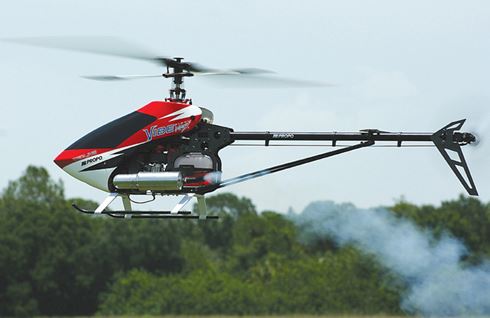Although helicopters have spinning rotor blades, they are no more dangerous than airplanes or any other form of RC. However, there are lessons to be learned that we can apply to our flying to improve safety in general. As an example, I heard about a pilot who was flying a helicopter in the backyard after some setup changes, when it went out of control and he found himself pinned between his house and a line of trees with nowhere to go. Whether it was an errant control input or some malfunction in the helicopter doesn’t really matter. The first point to be learned is that helicopters can go out of control, for any number of reasons. No matter how good a pilot we think we are, there will always be the occasional “brain lock” and bad command we didn’t plan on. It could also be some malfunction in the helicopter itself. The battery could go bad, or the switch or servo could fail, or any other problem that may arise. So, the real point is to never completely trust your helicopter, and always have a plan for the unexpected. It’s also a good idea to fly in an open field with plenty of room to maneuver, instead of near your house or in a confined area. I think the real issue is to always make sure you have an escape route if needed. However, there is more to safe flying, such as having constant awareness of what you are doing and seeing if there is a safer way to fly while still enjoying this great hobby of ours. Let’s take a look at a few examples that could make your flying just a little bit safer for you and your helicopter.
- If your on/off switch is exposed, such as not being under the canopy, mount it so the “on” position is toward the rear of the helicopter. There have been cases of helis flying over tall grass where the switch was pushed back to the “off” position after contact with the grass, a twig, etc. This can also happen during a mild tipover.
- After your helicopter batteries have been charged, give all your equipment an inspection to make sure everything is secure and in good working order. Some parts may need to be lubricated or adjusted, and this is a good time to do it rather than at the field when you are more apt to want to get in the air.
- Don’t go flying by yourself. Although I agree that flying at a large field gives you more room to run if needed, it’s still important to have someone else around to go for help if an accident should occur.
- If you have not used the radio for awhile, if it has just been repaired, or if there is any doubt about its performance, give it a range check before flying. I know of many pilots who perform a range check before the first flight of the day, which is really safe.
- When starting the helicopter, always assume it’s going to start at full throttle. There is always the case where the throttle stick is not at idle, the idle up switch is on, a servo is bad, or a linkage has come loose, etc. To protect myself from just any of the above, I position the helicopter so the fuel line going to the engine is right in front of me, and I have one hand firmly on the rotor head. This way, I can hold the head while I try to bring the throttle under control with the radio, and as a last ditch backup, I can always pull the fuel line off.
- Carry the helicopter away from the pit area before running up the engine. This seems so basic that it should not have to be mentioned, but there are still those who would rather hover and taxi than carry the helicopter a safe distance away.
- If you are using a two-stick radio, with the throttle on the left stick, carry the helicopter with your right hand. Hold the radio with your left hand, with your left thumb holding the throttle stick at idle. I have had the throttle stick brush up against my clothing, or neck strap, causing the engine to go to full power while I was carrying the helicopter. Now that really gets your attention! When hovering, stand clear of and to the side of the helicopter. If the helicopter should malfunction, your first thought should be to give a control input on the radio. If this does not help, your next thought should be to give a bigger correction. It’s only after two or three attempted corrections that you finally realize you don’t have control and start to take evasive action, which means “run” to most of us. If you are standing too close, the helicopter could be on you before you can get away.























